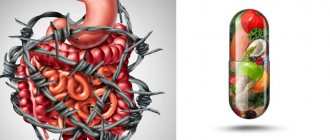Co-author, editor and medical expert - Klimovich Elina Valerievna.
Number of views: 1 696
Last updated date: 12/20/2021
Average reading time: 4 minutes
Bad habits, poor diet, sedentary lifestyle and lack of attention to one’s health can also sooner or later lead to the fact that normalizing stomach functions becomes task number one.
To understand how important the work of this body is, it is necessary to take a closer look at the work it performs.
Mechanical restoration
The walls of the stomach contract, which allows food to be crushed and gradually moved to the outlet into the intestines, in which other chemical elements continue to break down nutrients, absorb water and extract all the necessary beneficial elements from food.
Each of the stages is closely related to the others, so disruption of one of the processes inevitably entails consequences in the form of episodic or permanent digestive problems.
The most obvious manifestations are violations of motor functions - the movement of food into the intestines. With insufficient or chaotic contraction of the stomach walls, nausea, belching and other unpleasant symptoms develop. Episodic cases of motor impairment may be associated with overeating, the presence of a large number of “heavy” dishes on the menu - fried, fatty. If you have persistent or regular symptoms of indigestion, you should reconsider your entire lifestyle and even consult a doctor.
What remedies will help the gastrointestinal tract?
As a rule, they contain digestive enzymes and natural active ingredients:
- pancreatin – contains pancreatic enzymes (amylase, lipase and protease) necessary for the digestion of various types of food;
- papaya fruit powder – contains the plant enzyme papain, which is responsible for the absorption of food, improving the functioning of the gastrointestinal tract, and relieving spasms;
- pineapple bromelain – promotes rapid breakdown of food, burns excess fat;
- artichoke leaves – the powder of the leaves of this plant cleanses and restores the liver, protects it from toxins, and also normalizes the function of bile secretion;
- turmeric root extract – reduces stomach acidity, eliminates symptoms of heartburn and heaviness after eating, normalizes microflora and relieves inflammation.
Proper nutrition
Diet and a balanced diet are a factor of paramount importance for the normal functioning of the stomach. Compliance with a certain schedule for eating allows you to stabilize the secretion of gastric juice and normalize its motility. The diet must include whole grain porridge, fresh vegetables, fruits and hot first courses. It is useful to exclude sweets and baked goods from the menu, as well as instant and smoked foods.
You should avoid snacking on the go and set aside free time for eating.
Strict dietary restrictions or mono-diets (unless prescribed by a doctor) can also harm the stomach and cause persistent digestive disorders.
Mucous membranes are the body’s natural defense
As you know, no medicine, no vaccine, no special means of prevention against the new type of coronavirus have yet been developed. And it is unknown when all these funds will appear. But you need to protect your body. Medicine is well aware of the protective functions of mucous membranes. The stronger they are, the less chance there is for viruses. Therefore, now it is necessary not only to thoroughly wash your hands and observe self-isolation, but also to strengthen the mucous membranes of the respiratory tract and gastrointestinal tract. Moreover, this is easy to do: you don’t have to invent an effective remedy - it has existed for a long time.
Active lifestyle
Healthy activity involves regular stay in the fresh air, playing active sports (if you don’t have time or have poor physical fitness, at least walking or cycling). Physical activity normalizes blood circulation and improves the flow of nutrients and oxygen to all organs and tissues, which, among other things, has a positive effect on the functioning of the digestive system.
Quitting smoking and alcohol abuse will also benefit the gastrointestinal tract and help normalize stomach function.
Vasilenko V.V. Kinesitherapy of stomach diseases. Digest // GastroScan. 2022.
| Authors: Vasilenko V.V. |
Kinesitherapy of stomach diseases. Digest
Vladimir Vasilenko, gastroenterologist, member of the Russian Gastroenterological Association
The importance and impact of physical therapy on health are enormous, but for a long time they were in the shadow of the achievements of the pharmaceutical industry
Kinesitherapy, or therapeutic physical education, is the oldest branch of clinical medicine, which develops methods for using specific means of physical education in the complex treatment of various disorders. It is based on the natural biological function of the body - movement.
It is impossible to list all the positive effects of physical exercise on the systems and organs of a sick person. In this article, we present methods of therapeutic exercises that are effective in the treatment of two functional stomach disorders: hypokinetic dyspepsia (or “lazy stomach”), as well as ulcer-like dyspepsia.
It is advisable to use kinesitherapy in combination with therapeutic nutrition, and, if necessary, with drinking mineral waters. The effectiveness of physical therapy depends entirely on the regularity of exercise - it is advisable to do therapeutic exercises at least 2-3 times a week.
12 exercises for patients with a hypokinetic form of gastric dyspepsia (“chronic gastroduodenitis with reduced gastric secretion”)
Special therapeutic exercises are performed 1-2 hours before meals. We use exercises for the muscles of the anterior abdominal wall, diaphragm, perineum in starting positions (IP) lying on the back, sitting, standing. The ratio of breathing exercises (special, general developmental and relaxation) during an exacerbation of the disease is 2:1:1:1, subsequently 2:2:2:1. To add an emotional touch to the lessons, we recommend including musical accompaniment.
Lesson duration is 30-40 minutes. And 1-2 hours after eating - slow walking, a walk.
1. I.p. - lying on your back, legs straight, arms along the body. Alternately bend your legs at the knee joint. Breathing is free. The pace is average. Repeat 4-6 times with each leg.
2. I.p. - Same. Raise your straight legs one by one. Breathing is free. The pace is average. Repeat 4-6 times with each leg.
3. I.p. - Same. As you exhale, sit up from a lying position. At first, you can help yourself with your hands. While inhaling, return to IP. The pace is slow and smooth. Repeat 3-4 times. Note. After 1-2 weeks of training, in the absence of pain and other unpleasant sensations, exercises 1-3 can be complicated: exercises 1 and 2 can be performed simultaneously with both legs; Do exercise 3 with your hands on the back of your head.
4. I.p. - the same, hands under your head. Sliding your heels along the floor, bring your feet as close to your buttocks as possible, spread your knees to the sides, trying to reach the floor. Then connect your knees and straighten your legs, sliding your feet on the floor again. Do not hold your breath. The pace is slow. Repeat 3-4 times.
5. I.p. - knee-elbow. As you exhale, slowly straighten your legs at the knee joints, leaning on your toes and forearms. While inhaling, return to IP. The pace is slow. Repeat 2-4 times.
6. I.p. - the same, feet width apart. Moving your knees along the floor, bring them closer to your elbows, while rounding your back; then return to IP. The pace is average. Repeat 4-8 times.
7. I.p. - sitting on a stool, legs straight, hands on knees. As you inhale, spread your arms to the sides, while exhaling, bend forward, trying to reach the floor. Repeat 2-4 times.
8. I.p. - the same, hands on the belt. As you inhale, lean forward, as you exhale, lean back. The pace is slow and smooth. Repeat 2-4 times.
9. I.p. - standing, feet hip-width apart, hands on the belt. As you inhale, bend forward, as you exhale, return to i.p. The pace is average. Repeat 4-6 times.
10. I.p. - Same. Tilt your body to the sides. The pace is average. Repeat 4-6 times in each direction.
11. I.p. - the same, arms to the sides. As you exhale, tilt your body forward, moving your right arm back, and with your left, trying to reach the toe of your right foot; while inhaling, return to i.p. Then tilt, changing the position of your hands. The pace is average. Repeat 2-4 times.
12. I.p. - the same, hands in front of the chest. As you exhale, spread your arms to the sides and turn your body to the left, while inhaling, return to IP. Perform the same movement by turning the body to the right. The pace is average. Repeat 2-4 times in each direction.
14 exercises for patients with ulcer-like dyspepsia (“chronic gastroduodenitis with preserved secretion”)
Inhibition of the acid-secreting and motor functions of the stomach is achieved by performing physical exercises at a slow pace, with monotonous movements directly during periods of gastric discomfort. Lesson duration is 30-40 minutes.
I. Exacerbation period
1. Starting position (IP) - lying on your back, legs straight, arms along the body. Perform alternate bending of the legs at the knee joints, sliding the heel along the bed. Breathing is free. The pace is slow. Repeat 4-6 times with each leg.
2. I.p. - Same. As you inhale, raise your arms up behind your head, and as you exhale, cross them in front of your chest. The pace is slow. Repeat 2-3 times.
3. I.p. - Same. As you exhale, extend your arms and raise your head, and as you inhale, return to the i.p. The pace is slow. Repeat 3-4 times.
4. I.p. - the same, one hand on the chest, the other on the stomach. As you inhale, inflate your stomach like a balloon, raising the palm of the hand lying on it; As you exhale, draw in your stomach. The pace is slow. Repeat 2-3 times.
5. I.p. - sitting on a chair, hands on knees. As you inhale, simultaneously raise your two arms and right leg. As you exhale, return to IP. The pace is average. Repeat 3-4 times with each leg.
6. I.p. - Same. With your feet on your toes, perform a maximum spread of your legs to the sides. The pace is average. Repeat 4-6 times.
7. I.p. - Same. Raise your knees one by one with maximum amplitude. The pace is slow. Do not hold your breath. Repeat 4-6 times with each leg.
8. I.p. - Same. As you inhale, spread your arms to the sides, as you exhale, turn your body to the left, then perform the same movement to the right. The pace is slow. Repeat 2-3 times in each direction.
9. I.p. - standing, holding the back of the chair with your hand. Swing your leg back and forth with a medium range of motion. Do not hold your breath. The pace is average and smooth. Repeat 3-4 times with each leg.
10. I.p. - standing, feet shoulder-width apart, arms down. As you inhale, raise your arms up and bend back a little; As you exhale, lower your arms down, leaning forward. Repeat 2-3 times.
II. Quiet period
1. I.p. - sitting on the floor, leaning on your arms bent at the elbow joints. As you exhale, lift your legs and use surrounding movements (“scissors”) to lift them higher and higher. While inhaling, return to IP. The pace is average. Repeat 10-12 times.
2. I.p. - lying on your stomach, hands under your chin. As you exhale, raise your legs, spread them, bring them together; while inhaling, lower it. The pace is average. Repeat 10-12 times.
3. I.p. - lying on your back, arms under your head, cuffs with weights (up to 2 kg) are put on the ankle joints. As you exhale, raise your legs (lifting angle up to 45°), while inhaling, lower them. The pace is average. Repeat 10-12 times.
4. I.p. - lying on an inclined plane, head on the elevated end. As you exhale, raise your legs (lifting angle 90°); while inhaling, return to I.p. The pace is average. Repeat 10-12 times.
5. I.p. - lying on an inclined plane, legs on the elevated end. As you exhale, raise your body, while inhaling, lower it. The pace is average. Repeat 10-12 times.
6. I.p. - lying on your back, holding dumbbells (weighing up to 2 kg) in your arms extended above your head. As you exhale, sit down, lowering your hands down between your feet; while inhaling, return to I.p. The pace is average. Repeat 6-10 times.
7. I.p. - the same, hands with dumbbells to the shoulders, feet fixed. As you exhale, sit down, while inhaling, return to I.P. The pace is average. Repeat 6-10 times.
8. I.p. - standing, feet shoulder-width apart, left hand on the belt, dumbbell in the lowered right hand. As you exhale, raise your right arm up, and as you inhale, lower it. Keep your back straight. The pace is average. Repeat 8-12 times. Same with the other hand.
9. I.p. - the same, legs together, dumbbells in lowered hands. As you exhale, raise your arms up through your sides, and as you inhale, lower them. The pace is average. Repeat 10-12 times.
10. I.p. - the same, with dumbbells in raised hands. As you inhale, tilt your body forward (tilt angle 90°), as you exhale, return to I.P. The pace is average. Repeat 4-6 times.
11. I.p. - the same, dumbbells in lowered hands. As you exhale, raise your arms straight out to the sides, and as you inhale, lower your arms in front of you. Repeat 6-8 times.
12. I.p. - the same, with dumbbells in the hands raised up, legs wider than shoulders. As you exhale, bend forward deeply, moving your straight arms back between your widely spaced legs. While inhaling, return to IP. Repeat 6-8 times.
13. I.p. - the same, arms with dumbbells are lowered, legs are foot-width apart. As you exhale, squat down, spreading your arms to the sides. While inhaling, return to IP. Repeat 10-12 times.
14. I.p. - the same, arms with dumbbells lowered, legs together. Perform jumps, spreading your arms to the sides. Do not hold your breath, keep your back straight. The pace is average.
V.V. Vasilenko. Sixty essays on digestion (recommendations from a gastroenterologist to patients) Back to section









